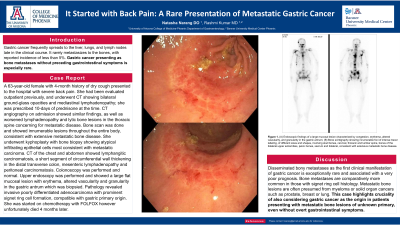Monday Poster Session
Category: Stomach
P2805 - It Started With Back Pain: A Rare Presentation of Metastatic Gastric Cancer
Monday, October 23, 2023
10:30 AM - 4:15 PM PT
Location: Exhibit Hall

Has Audio
.jpg)
Natasha Narang, DO
University of Arizona College of Medicine
Phoenix, AZ
Presenting Author(s)
Natasha Narang, DO, Rashmi Kumar, MD
University of Arizona College of Medicine, Phoenix, AZ
Introduction: Gastric cancer frequently spreads to the liver, lungs, and lymph nodes late in the clinical course. It rarely metastasizes to the bones, with reported incidence of less than 5%. Gastric cancer presenting as bone metastases without preceding gastrointestinal symptoms is especially rare. We report a case of a 63-year-old female with back pain, found to have diffuse lytic and sclerotic bone metastases; endoscopy showed a flat region of abnormal antrum mucosa, and biopsy confirmed gastric carcinoma.
Case Description/Methods: A 63-year-old female with 4-month history of dry cough presented to the hospital with severe back pain. She had been evaluated outpatient previously, and underwent CT showing bilateral ground-glass opacities and mediastinal lymphadenopathy; she was prescribed 10-days of prednisone at the time. CT angiography on admission showed similar findings, as well as worsened lymphadenopathy and lytic bone lesions in the thoracic spine concerning for metastatic disease. Bone scan was done and showed innumerable lesions throughout the entire body, consistent with extensive metastatic bone disease. She underwent kyphoplasty with bone biopsy showing atypical infiltrating epithelial cells most consistent with metastatic carcinoma. CT of the chest and abdomen showed lymphangitic carcinomatosis, a short segment of circumferential wall thickening in the distal transverse colon, mesenteric lymphadenopathy and peritoneal carcinomatosis. Colonoscopy was performed and normal. Upper endoscopy was performed and showed a large flat mucosal lesion with erythema, altered vascularity and granularity in the gastric antrum which was biopsied. Pathology revealed invasive poorly differentiated adenocarcinoma with prominent signet ring cell formation, compatible with gastric primary origin. She was started on chemotherapy with FOLFOX however unfortunately died 4 months later.
Discussion: Disseminated bony metastases as the first clinical manifestation of gastric cancer is exceptionally rare and associated with a very poor prognosis. Bone metastases are comparatively more common in those with signet ring cell histology. Metastatic bone lesions are often presumed from myeloma or solid organ cancers such as prostate, breast or lung. This case highlights cruciality of also considering gastric cancer as the origin in patients presenting with metastatic bone lesions of unknown primary, even without overt gastrointestinal symptoms.

Disclosures:
Natasha Narang, DO, Rashmi Kumar, MD. P2805 - It Started With Back Pain: A Rare Presentation of Metastatic Gastric Cancer, ACG 2023 Annual Scientific Meeting Abstracts. Vancouver, BC, Canada: American College of Gastroenterology.
University of Arizona College of Medicine, Phoenix, AZ
Introduction: Gastric cancer frequently spreads to the liver, lungs, and lymph nodes late in the clinical course. It rarely metastasizes to the bones, with reported incidence of less than 5%. Gastric cancer presenting as bone metastases without preceding gastrointestinal symptoms is especially rare. We report a case of a 63-year-old female with back pain, found to have diffuse lytic and sclerotic bone metastases; endoscopy showed a flat region of abnormal antrum mucosa, and biopsy confirmed gastric carcinoma.
Case Description/Methods: A 63-year-old female with 4-month history of dry cough presented to the hospital with severe back pain. She had been evaluated outpatient previously, and underwent CT showing bilateral ground-glass opacities and mediastinal lymphadenopathy; she was prescribed 10-days of prednisone at the time. CT angiography on admission showed similar findings, as well as worsened lymphadenopathy and lytic bone lesions in the thoracic spine concerning for metastatic disease. Bone scan was done and showed innumerable lesions throughout the entire body, consistent with extensive metastatic bone disease. She underwent kyphoplasty with bone biopsy showing atypical infiltrating epithelial cells most consistent with metastatic carcinoma. CT of the chest and abdomen showed lymphangitic carcinomatosis, a short segment of circumferential wall thickening in the distal transverse colon, mesenteric lymphadenopathy and peritoneal carcinomatosis. Colonoscopy was performed and normal. Upper endoscopy was performed and showed a large flat mucosal lesion with erythema, altered vascularity and granularity in the gastric antrum which was biopsied. Pathology revealed invasive poorly differentiated adenocarcinoma with prominent signet ring cell formation, compatible with gastric primary origin. She was started on chemotherapy with FOLFOX however unfortunately died 4 months later.
Discussion: Disseminated bony metastases as the first clinical manifestation of gastric cancer is exceptionally rare and associated with a very poor prognosis. Bone metastases are comparatively more common in those with signet ring cell histology. Metastatic bone lesions are often presumed from myeloma or solid organ cancers such as prostate, breast or lung. This case highlights cruciality of also considering gastric cancer as the origin in patients presenting with metastatic bone lesions of unknown primary, even without overt gastrointestinal symptoms.

Figure: Figure 1. (A) Bone scintigraphy showing innumerable foci of intense tracer labeling, of different sizes and shapes, involving skull bones, cervical, thoracic and lumbar spine, bones of the bilateral upper extremities, pelvic bones, sacrum and bilateral, consistent with extensive metastatic bone disease; (B) Endoscopic findings of a large mucosal lesion characterized by congestion, erythema, altered vascularity, and granularity in the gastric antrum.
Disclosures:
Natasha Narang indicated no relevant financial relationships.
Rashmi Kumar indicated no relevant financial relationships.
Natasha Narang, DO, Rashmi Kumar, MD. P2805 - It Started With Back Pain: A Rare Presentation of Metastatic Gastric Cancer, ACG 2023 Annual Scientific Meeting Abstracts. Vancouver, BC, Canada: American College of Gastroenterology.
